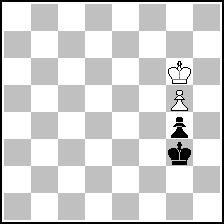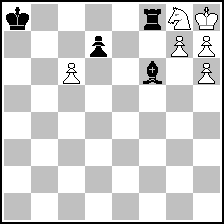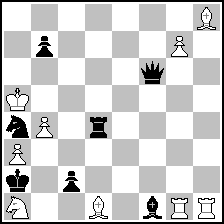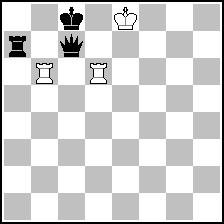
Website founded by
Milan Velimirović
in 2006
2:29 UTC


| |
MatPlus.Net  Forum Forum  General General  One move to the destination One move to the destination |
| |
|
|
|
|
You can only view this page!
| | | (1) Posted by Sarah Hornecker [Tuesday, Feb 2, 2010 00:40]; edited by Sarah Hornecker [10-02-02] | One move to the destination
I'd like to show the use of the ultimate minimum of time in studies: One move!
Let's start with two positions, the theoretical discussion can follow then.
 (= 2+2 ) (= 2+2 )
Mikhail Zinar
64-Shakmatnoe Obozrenie 1984
White wins
1.Kf5! wins easily.
1.Kh5 however only would be a draw in sight of 1...Kh3! 2.g6 g3 3.g7 g2 4.g8Q g1Q 5.Qxg1 stalemate.
 (= 2+2 ) (= 2+2 )
A. John Roycroft
Die Schwalbe 1975
White wins
1.Kh7! wins.
1.g7? Kh6! 2.g8Q Bf6+ would imprison the white king and only draw.
Would any of these studies benefit from an introduction? In my opinion not. People would lay their whole concentration on the introduction, maybe even without seeing that the real point of the study lies in the last move. Yes, this theme is another highly controversial one, and like in philosophy when there are 10 people they should have 20 different opinions.
In my opinion economy should not only be made with material but also with moves. Earlier I thought that adding an introduction would contribute to a study but now I'm not too sure anymore. Sure, for some studies the introduction is essential - for example my stalemate study from MatPlus 2007 - but on studies that just center around a certain point that can be seen - in the worst case - as just another unique move by coincidence instead of the point, composers should think if the intro does good or bad. On a remarkable ending - mate, stalemate, underpromotion, etc. - the intro won't do harm, but on one like above it easily could do. However, if the intro is still made it should be the author who has to point out that the point is in the final move to assist the judge who might easily overlook it.
So let me hear your opinion now!
| | | (2) Posted by Miodrag Mladenović [Tuesday, Feb 2, 2010 13:41] |
Quote:
QUOTE
Would any of these studies benefit from an introduction? In my opinion not.
Why not? If white sacrifice queen or some other piece during the introduction, there is a benefit. I think it's impossible to generalize rule about this. It mainly depends on the play that is added.
| | | (3) Posted by Sarah Hornecker [Tuesday, Feb 2, 2010 14:20]; edited by Sarah Hornecker [10-02-02] |
Dear Misha,
I already explained why not. The introductory play would take the attention and the last move might only be seen as a random unique move instead the real intention. Of course, here I agree, de gustibus non est disputandum and it also depends on the kind of introduction. If the introduction is mainly made without special points but with endgame technique or so the study might benefit. The queen sacrifice you mentioned would go into danger of being seen as the real point.
On a greater point of view we could classify for one-movers what is for other compositions as well.
A good one-mover study should have:
A thematic try
A solution
 (= 6+4 ) (= 6+4 )
Karl Fabel
Hamburgischer Correspondent 1932
White to move and draw
Thematic try: 1.cxd7? Rb8! 2.d8~ Bxd8 3.Se7 Bxe7+ 4.g8Q Bf6 mate
Solution: 1.c7 Rc8 stalemate
 (= 9+7 ) (= 9+7 )
K. Eucken
L'Italia Scacchistica 1947
White to move and win
Thematic try: 1.g8Q+? Kxa1 2.Bxf6 b6+ 3.Kxa4 d1B+!! 4.Qb3 Bb5+ 5.Kxb5 stalemate
Solution: 1.g8B+!! wins
| | | (4) Posted by Kevin Begley [Wednesday, Feb 3, 2010 15:52]; edited by Kevin Begley [10-02-03] |
Here's a very simple "one-mover" that I created (~1 year ago)...
Actually, I only took a mutual zugzwang position from the EGTB, and added a 1 move introduction, to produce a thematic try.
I never investigated the possibilities for an introduction -- the idea seems better conveyed in its simplest form:
 (= 3+3 ) (= 3+3 )
White draws (+ thematic try)
C+
The solution (and thematic try) are not so difficult, so I'll leave this as an exercise for the reader (to solve, or check tables).
I wouldn't be surprised if an anticipation exists -- it becomes especially difficult to find anticipations (via computer search) if an introduction is added.
| |
No more posts |
MatPlus.Net  Forum Forum  General General  One move to the destination One move to the destination |
|
|
|
 ISC 2024
ISC 2024 Forum
Forum  General
General  One move to the destination
One move to the destination 


